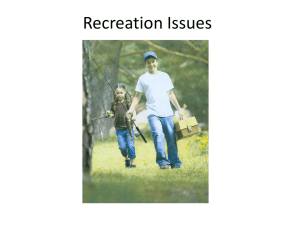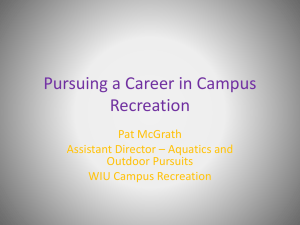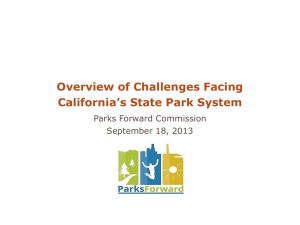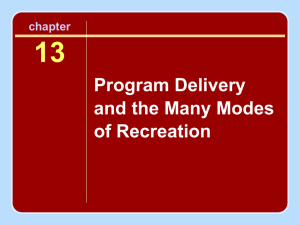Microsoft Powerpoint
advertisement
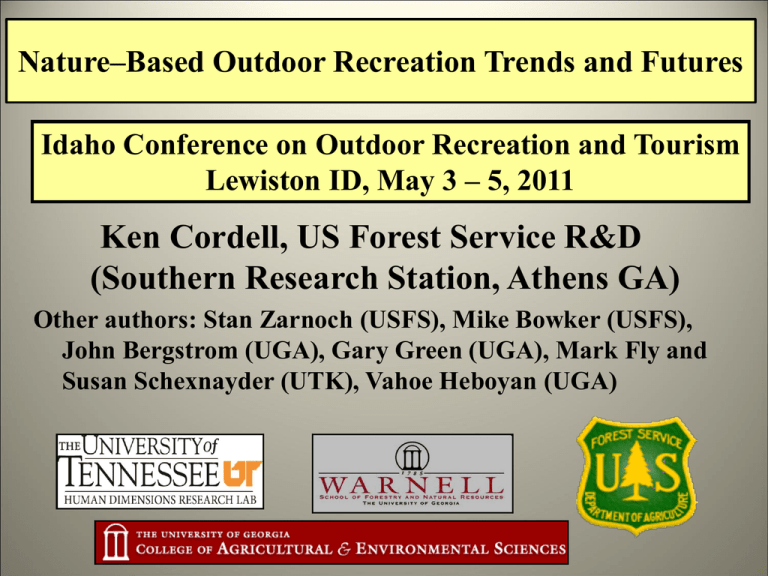
Nature–Based Outdoor Recreation Trends and Futures Idaho Conference on Outdoor Recreation and Tourism Lewiston ID, May 3 – 5, 2011 Ken Cordell, US Forest Service R&D (Southern Research Station, Athens GA) Other authors: Stan Zarnoch (USFS), Mike Bowker (USFS), John Bergstrom (UGA), Gary Green (UGA), Mark Fly and Susan Schexnayder (UTK), Vahoe Heboyan (UGA) Nature–Based Outdoor Recreation Trends and Futures Ken Cordell, US Forest Service R&D (Southern Research Station, Athens GA) Other authors: Stan Zarnoch and Mike Bowker (USFS), John Bergstrom (UGA) and Gary Green (UGA), Mark Fly and Susan Schexnayder (UTK) and Vahe Heboyan (UGA) Forest Service RPA Regions of the U. S. It is based on the Forest Service 2010 RPA National Assessment and is original research Our published research for the 2010 Assessment includes: •National to County Population Projections •Recreation Demand Trends and Futures in the U. S. to 2060 •Recreation and Protected Land Resource Trends and Futures •Natural Amenity Effects on Population Migration in the U. S. Trend Summaries • • • • • • Population and demographics Visitation to public lands Outdoor recreation participation trends Kids time outdoors Forecasts of future outdoor recreation The draw of natural amenities and rural population growth Population and Demographic Change • What is happening with population growth and are there increasing concentrations in some places (persons per square mile)? • Is the age distribution of the U. S. population changing and which age groups are growing or shrinking? • How has the race/ethnic makeup of the U. S. population been changing over the last 20 years? RPA is unique in that it Tracks Trends and Forecasts Futures Region & Sub-Region Northeast North Central North Total Southeast South Central South Total Great Plains Intermountain Rocky Mountains Total Alaska Pacific Northwest Pacific Southwest Pacific Coast Total U. S. Total Total population Population Percent of National 63,245.9 61,122.0 20.8 20.1 124,368.0 40.9 49,485.4 53,320.2 16.3 17.5 102,805.6 33.8 6,031.2 2.0 21,729.6 27,760.9 7.1 9.1 683.2 10,339.3 38,044.9 0.2 3.4 12.5 49,067.4 304,001.8 16.1 100.0 Persons per square mile (current) Population growth by county since 1990 Idaho ranked fourth among states in percentage population growth – 21 percent - from April 2000 to April 2010---Over 2 percent per year 2008 population by region and age group with percent change since 1990 (Population is in 1,000s) Age Group Under 6 Rocky Mountains 2,555.8 % change United States 37.7 25,082.3 % change 12.0 Age 6-10 1,941.7 24.1 19,897.3 10.2 Age 11-15 1,897.9 34.5 20,346.1 21.5 Age 16-24 3,544.3 41.8 38,373.4 13.8 Age 25-34 3,965.7 22.7 40,931.6 -5.2 Age 35-44 3,679.9 28.7 42,501.1 13.5 Age 44-54 3,861.1 44,372.1 Age 55-64 2,989.5 111.2 96.1 33,686.2 77.0 59.5 Age 65+ 3,379.6 48.6 38,869.7 25.0 27,815.7 46.0 304,059 22.2 Total Current population by region and by race/ethnicity with percent change since 1990 (population is in 1,000s) Rocky Mountains 19,479.6 % change 25.3 United States 199,491.5 African American 952.9 69.4 37,171.8 26.8 American Indian 768.9 38.3 2,329.0 29.6 Asian or Pacific Islander 690.5 171.1 13,672.3 95.4 Hispanic 5,497.2 157.8 46,943.6 109.8 U. S. All Races 27,815.7 46.0 304,059.7 22.2 2 or more races 426.6 . 4,451.7 . Race/ Ethnicity White % change 5.9 Percent change in Hispanic population since 1990 The Hispanic population in Idaho is about 176K, up 73%. In 2000 it was 101,690. Non-Hispanic population increased 16.7% Population and Demographic Change • Growth (population per square mile) has occurred almost everywhere, especially the Northeast coast, the Southern Appalachians, Atlanta, Chicago, Denver, Salt Lake City, the Southwest, Portland and Seattle • The fastest growing age has been ages 44-54 and 55-64, with next fastest being 65 or older. There has been a decline in age group 25-34 • Growing especially fast is the Hispanic population in the Southeastern states, states bordering the Mississippi River, the upper Mid-West, Arizona, Utah, Wyoming, coastal Oregon and Washington, and Idaho • Changing population and its demographics have affected outdoor recreation trends How Have Demographics Affected Outdoor Recreation Participation? (Current RPA Research) Models developed for forecasting for the 2010 RPA Black (neg) Native Amer. (pos) Asian (neg) Hisp (neg) – except for Day Hiking Educ (neg) – consumptive & motor activities Educ (pos) – nonconsumptive Income (pos) – most activities Gender – (pos) boys still play more outside Population density (neg) – crowding or urban effect? Resource availability (positive) Land, forests, open space, water, etc. Bowker, et al, RPA in press Outdoor Recreation Participation Trends • Is use of public land up, down, what? • How do peoples’ choices for outdoor recreation compare with previous generations, and is there an overriding trend • What is the general trend for nature-based recreation, is it growth? • Have any traditional activities shown decline (e.g., hunting). • If nature-based outdoor recreation is growing, are there activities and interests that stand out? What about visitation to public lands? Federal Lands (3 UP, 1 Steady, 1 Down) Year NPS F&WS 1996 266 30 2000 286 2004 BLM USFS Corps 57 ----- 372 37 54 ----- ----- 277 40 54 205 359 2008 275 41 57 176 357 2009 286 43 57 174 370 What about visitation to public lands? State Park Systems/ Rocky Mountain Region • 1992 49.0 • 1995 58.9 • 2000 58.9 • 2005 62.9 • 2009 64.3 224 208 +7.5% 81 80 200 +32.5% 60 61 150 Billions of days Millions who participate General outdoor recreation demand growth by people age 16+ (number of people and annual participation days), 2000–2009. 250 100 40 2000 Year Number Who Participate (million) 2009 Number of Activity Days (billion) Source: National Survey on Recreation and the Environment (NSRE) 250 60 52 200 196 +7.1% 210 40 +40.1% 150 37 40.1 vs. 32.5 100 20 2000 2009 Year Number Who Participate (million) P45+ Billions of days Millions who participate Nature-based outdoor recreation growth (number of people and annual participation days, 2000–2009 Activity Walk for pleasure Gathering of family/friends Gardening/landscaping for pleasure View natural scenery Visit outdoor nature center/zoo Sightseeing Picnicking View wildflowers/trees Driving for pleasure View wildlife besides birds and fish Visit historic sites/monuments Visit a beach Swimming in lakes, streams, etc. Bicycling View or photograph birds Day hiking Visit a wilderness Gather mushrooms/berries Visit farm or agricultural setting View salt/freshwater fish Visit waterside besides beach Developed camping Warmwater fishing Motorboating 1999-2001 2005-2009 Total participants …….. 128.2 --110.9 117.5 112.1 --62.8 91.6 128.8 87.4 77.8 54.3 53.5 ---27.6 -46.5 49.3 59.5 175.6 157.6 140.8 127.1 121.0 109.0 118.3 93.8 107.9 94.2 96.1 84.4 85.5 81.9 68.5 69.1 67.2 60.0 58.6 52.3 53.2 55.3 47.6 50.7 200.0 174.2 157.9 149.8 133.3 123.9 121.6 121.3 120.5 118.1 103.9 102.0 97.5 88.3 84.1 79.7 79.1 77.2 75.3 63.5 56.5 56.0 55.7 55.0 2005-2009 85.0 74.0 67.1 63.7 56.6 52.7 51.7 51.6 51.2 50.2 44.1 43.3 41.5 37.5 35.7 33.9 33.6 32.8 32.0 27.0 24.0 23.8 23.7 23.4 1999-2001 to 2005-2009 13.9 10.5 12.1 17.9 10.2 13.7 2.8 29.4 11.6 25.4 8.1 20.7 14.0 7.8 22.8 15.4 17.7 28.6 28.6 21.4 6.3 1.1 17.1 8.6 Four of the top five fastest growing activities between periods 1999-2001 and 2005-09 were nature based View wildflowers/trees Participants per year Activity Visit farm or agricultural setting Gather mushrooms/berries View wildlife besides birds and fish View or photograph birds 0 20 40 60 80 100 Participants 2005-2009 Total participants (millions) P41+ 1999-2001 Total participants (millions) 120 140 Millions Fishing participation: 1996 to 2006 (population 16 years of age or older, numbers in millions) 36 35 34 33 32 31 30 29 28 27 1996 Source: U.S. Fish and Wildlife Service 2001 Year 2006 Declining Hunting participation 1996-2006 (population 16 years of age or older, numbers in millions) 14.5 Declining Millions 14.0 13.5 13.0 12.5 12.0 11.5 1996 Source: U.S. Fish and Wildlife Service 2001 Year 2006 Wildlife watching 1996-2006 (population 16 years or older, numbers in millions) 72 Millions 70 68 66 64 62 60 58 1996 2001 2006 Year Source: U. S. Fish and Wildlife Service Wildlife watching in 2006 (population 16 years of age or older, numbers in millions) Away from home Around the home Total 0 Source: U. S. Fish and Wildlife Service 20 40 60 Millions 80 Trend for four activities to illustrate changing outdoor recreation choices Shows Changing Activity Mix 16 14 Millions 12 10 8 6 4 2 0 Kayaking Snowboarding Snowmobiling Cross-country skiing Activity 1994-1995 1999-2001 2005-2009 Indexed moving average of total activity days for activities associated with visiting recreation or historic sites 2000 to 2008 Moving average index 1 0.5 Recent Trends in Days, a better indicator of demand trend 0 Zero means no change relative to 2000 -0.5 In 2006, real personal income turned down -1 2000 2001 2002 2003 2004 Year 2005 2006 2007 2008 Developed camping Family gathering Picnicking Visit a beach Visit historic sites Visit prehistoric/archeological sites Indexed moving average of total activity days for nonmotorized boating activities for year 2000 to 2008 Moving average index 1 0.5 0 -0.5 -1 2000 2001 Canoeing 2002 2003 Kayaking 2004 Year 2005 Rafting 2006 Rowing 2007 Sailing 2008 Moving average index Indexed moving average of total activity days for snow skiing and boarding activities for year 2000 to 2008 1 0.5 0 -0.5 -1 2000 2001 2002 2003 2004 2005 2006 2007 2008 Year Cross country skiing Downhill skiing Snowboarding Indexed moving average of total activity days for viewing and photographing nature activities for year 2000 to 2008 Moving average index 1 0.5 0 -0.5 -1 2000 2001 2002 2003 2004 2005 2006 2007 2008 Year View/photograph birds View/photograph natural scenery View/photograph other wildlife View/photograph wildflowers, trees, etc. Visit nature centers, etc. Moving average index Indexed moving average of total activity days for seven composites of nature-based activities for year 2000 to 2008 1 Inexpensive 0.5 0 Expensive -0.5 -1 2000 2001 2002 2003 2004 2005 2006 2007 2008 Year Visit Recreation And Historic Sites Backcountry Activities Hunting And Fishing Snow Skiing And Boarding Viewing/Photographing Nature Motorized Activities Non-Motor Boating Moving average index 1 0.5 0 -0.5 -1 •Motorized activities, along with hunting, fishing, and backcountry activities, ended up at about the same level as 2000 2000 2001 2002 2003 2004 2005 2006 2007 2008 •Non-motor boating and visiting Year recreation and historic sites Visit Recreation And Historic Sites grew modestly Viewing/Photographing Nature Backcountry Activities •Various forms of skiing, Motorized Activities Hunting And Fishing including snowboarding, Non-Motor Boating declined •The clear leader was the overall group of activities named “viewing and photographing nature”. Boise National Forest Archives Keeping numbers in perspective (NSRE) Total Annual Days (millions) 14000 12000 10000 8000 6000 4000 2000 0 Visit farm or agricultural setting View View natural wildflowers/trees scenery View wildlife besides birds & fish Off-highway vehicle driving Activity 1999-2001 2005-2009 Viewing natural scenery attracts 12 to 13 times the number of participation days as does OHV driving ( Do Kids Spend Time Outdoors? • What does research show about kids being outside, how much time outdoors? • Is there a trend? • What activities do youth prefer and participate in? • What research is needed to help us understand kids outdoors and kids and nature? National Kids Survey National Kids Survey Results Amount of time /day outside • • • • • • None Less than 1/2 hour a day About 1/2 hour a day About 1 hour 2-3 hours 4 or more hours Weekday 2.3 4.2 8.1 3.0 33.9 28.5 Weekend 3.8 2.2 3.5 13.3 27.4 49.8 Source: National Kids Survey, NSRE 2007-2011. N=1,945. Youth time trend on typical weekdays and weekend days during the past week by interview time period Consistent results across three identical national surveys Amount of time Weekday Weekend day September August May '09 September August May '09 '07 '08 to '07 '08 to to to February to to February July '08 April '09 '11 July '08 April '09 '11 None 4.5 1.2 1.8 6.1 3.2 2.8 Less than 1/2 hour a day About 1/2 hour a day About 1 hour 5.2 4.3 3.3 1.9 2.3 2.2 9.1 8.2 7.3 3.9 4.3 2.3 18.5 26.4 23.0 12.7 11.7 15.3 2-3 hours 32.8 30.5 38.0 27.6 27.6 27.1 4 or more hours 29.9 29.5 26.6 47.7 50.8 50.3 Amount of time spent outdoors by youth on a typical WEEKEND DAY during the past week, by age and gender Time Age 6-9 Age 10-12 Age 13-15 Age 16-19 Male Female Male Female Male Female Male Female 4.9 3.4 3.0 8.5 1.6 5.3 7.9 11.7 • ½ to 1 hour 12.5 12.4 12.8 15.1 12.0 20.0 25.0 23.9 • 2-3 hours 27.0 30.9 24.5 26.3 31.4 32.0 18.4 31.0 • 4 + hours 55.6 53.3 59.7 50.0 55.0 42.8 48.7 33.4 • < 1/2 hour Assumptions Reality ( Outdoor Recreation Participation Summary • Visitation to public lands varies by agency, some up, some down • Overriding trends = very different activities now, growth of nature-based recreation, especially viewing and photographing nature. • Different segments of society chose different types and levels of outdoor activities. • There is evidence that America’s youth do spend time outdoors and for some it is substantial. •Public lands continue to be highly important due to the recreation opportunities they offer. •What about Future Trends? Increases for some activities and declines for others? National population projection---RPA forecasts 550 500 A Look to the Future… 50 505 450 447 400 397 350 300 250 2000 2007 2010 2020 2030 2040 2050 2060 A2 Scenario Year A1/Census Scenario B2 Scenario Moscow Boise Twin Falls Forecast population, income, land use change for all counties in U. S. (including AK and HI) Why is population growth important? Forecasting Future Supply Nine basic resources that form the foundation for nature-based outdoor recreation and tourism: •Federal and state park land •Water •Forest •Open range and pasture •Ocean and Great Lakes coast •Mountains •Snow cover •Specially designated federal lands •Private recreation businesses Water area Water area per capita 2060 Sub-region & region Northeast North Central North Region Southeast South Central South Region Great Plains Intermountain Rocky Mountains Region Alaska Pacific Northwest Pacific Southwest Pacific Coast Region U. S. Total Total Per capita acres, 2008 acres, 2008 14,328.5 0.23 42,505.3 0.70 56,833.8 0.46 15,068.8 0.30 14,213.4 0.27 29,282.1 0.28 2,495.3 0.41 Projected per capita acres, 2060 0.18 0.55 0.36 0.18 0.18 0.18 0.32 Proportion of 2008 acres projected for 2060 0.79 0.79 0.79 0.60 0.66 0.63 0.76 4,793.4 0.22 0.11 0.52 7,288.8 0.26 0.15 0.56 58,442.2 4,569.2 7,836.5 70,848.0 164,252.7 85.54 0.44 0.21 1.44 0.54 50.43 0.27 0.13 0.93 0.37 0.59 0.61 0.65 0.64 0.68 Water per capita forecast to 2060 Indexed Per-Capita Participation in Birding : Comparison of Weather Models for A1B Indexed Per-Capita Participation in Fishing: Comparison of Weather Models for A1B 1.02 1 0.98 Index Index 1.1 1.08 1.06 1.04 1.02 1 0.98 0.96 0.94 CGCM31 A1B 0.92 CSIROMK A1B 0.9 MIROC32 A1B 0.88 0.96 0.94 0.92 A1B Without Weather 0.86 2008 2008 2010 2020 2030 2040 2050 2010 2020 2030 2040 2050 2060 2060 Forecasting Future Demand 1.12 1.1 1.08 1.06 1.04 1.02 1 0.98 0.96 0.94 0.92 0.9 Indexed Per-Capita Participation in Hunting: Comparison of Weather Models for A1B 1.2 1 Index Index Indexed Per-Capita Participation in Hiking: Comparison of Weather Models for A1B 0.8 CGCM31 A1B 0.6 CSIROMK A1B MIROC32 A1B 0.4 A1B Without Weath 0.2 2008 2010 2020 2030 2040 2050 2060 0 2008 2010 2020 2030 2040 2050 2060 Forecast index of per-capita participation, 2060 • Developed site use 1.026 • Visiting interpretive site 1.089 • Birding 1.075 • Viewing nature 1.035 • Challenge activities 1.176 • Equestrian activities 1.186 • Day hiking 1.097 Forecast index of per-capita participation, 2060 • • • • • • • • • • Visiting primitive areas Motorized off-road activities Motorized water use Motorized snow use Hunting Fishing Developed skiing Undeveloped skiing Swimming Canoeing, kayaking, or rafting 0.995 0.995 1.154 1.026 0.781 0.970 1.570 1.309 1.109 1.031 Forecasting Rural Population Migration Trends and Patterns in the United States and Their Relationship to Natural Amenities •Results suggest a direct impact of changing natural amenities and climate change on rural population migration •Data project population shift from Midwest •Shift to Inter-Mountain and Pacific Northwest Regions, the Southern Appalachian and Ozark Mountains, and northern New England. H. Ken Cordell Vahé Heboyan Florence Santos John C. Bergstrom Average Effects of Natural Amenities on Rural Population Net Migration 1% increase in cropland will cause rural population to decrease by 230. 1 degree (Celsius) increase in average summer temperature will cause rural population to decrease by 299. 1 millimeter increase in average monthly precipitation will cause rural population to decrease by 2. 1% increase in percent water area will increase rural population by 603. 1% increase in mountainous area will increase rural population by 25. Coastal counties (compared to non-coastal counties) will in average experience an increase in rural population by 1,319. 1% increase in wetland area will cause rural population to decrease by 17. 52 Key Findings • People prefer rural areas with mild winters and cooler summers. • Preference is for varied landscapes that feature a mix of forest land and open space. • Effect of changes in natural amenities on rural population migration (2010-2060) – Positive effect • Inter-mountain and Pacific Northwest regions • Parts of the Southeastern, South Central, and Northeastern U.S. – e.g., Southern Appalachian Mountains, Ozark Mountains, northern New England. – Negative effects • Midwestern regions (e.g., Great Plains and North Central). 53 Forecasted Effect of Natural Amenities on Rural Population Change, 2007-2020, 2010 RPA Climate Scenario A1B, Projection CGCM 3.1 54 Policy Implications of Amenity Migration Findings • Due to changing natural resources and climate, models suggest possible population gains in Inter-mountain and Pacific Northwest and Southern Appalachian Mountains, Ozark Mountains, northern New England. Midwest may lose population. • Population gaining regions can capitalize on potential to attract upper-income migrants who have high values for natural amenities including favorable climate. • Land management agencies and local governments should work to protect landscapes such as mix of forest land and open space valued by amenity migrants. • Rising sea-levels under future global climate change projections may significantly alter the quantity and quality of water-related amenities (US Atlantic, Pacific, Gulf of Mexico, 55 Great Lakes). Trend Summaries • • • • • • Population and demographics Visitation to public lands Outdoor recreation participation trends Kids time outdoors Forecasts of future outdoor recreation The draw of natural amenities and rural population growth Summary---Population and Demographic Change • Growth (population per square mile) has occurred almost everywhere, especially the Northeast coast, the Southern Appalachians, Atlanta, Chicago, Denver, Salt Lake City, the Southwest and Portland and Seattle • The fastest growing age has been ages 44-54 and 55-64, with next fastest being 65 or older. There has been a decline in age group 25-34 • Growing especially fast is the Hispanic population in the Southeastern states, states bordering the Mississippi River, the upper Mid-West, Arizona, Utah, Wyoming, coastal Oregon and Washington, and Idaho • Changing population and its demographics affect outdoor recreation trends Summary, Public Land Visitation • National Park and Wildlife Refuge Visitation have wavered, but, relative to base year 1996, NP and WR visitation is up about 33 million per year • Forest Service visitation estimates have shown declines • State park visitation has also wavered over the last few years, but relative to 1992, it is up by over 14 million Moving average index Summary of this decade’s trends 1 0.5 0 -0.5 -1 •Motorized activities, along with hunting, fishing, and backcountry activities, ended up at about the same level as 2000 2000 2001 2002 2003 2004 2005 2006 2007 2008 •Non-motor boating and visiting Year recreation and historic sites Visit Recreation And Historic Sites grew modestly Viewing/Photographing Nature Backcountry Activities •Various forms of skiing, Motorized Activities Hunting And Fishing including snowboarding, Non-Motor Boating declined •The clear leader was the overall group of activities named “viewing and photographing nature”. Boise National Forest Archives ( Outdoor Recreation Participation Summary • Overriding trends = very different activities now, growth of nature-based recreation, especially viewing and photographing nature. • Different segments of society chose different types and levels of outdoor activities. • There is evidence that America’s youth do spend time outdoors and for some it is substantial. • Public lands continue to be highly important due to the recreation opportunities they offer. •Visitation to public lands varies by agency, some up, some down • What about Future Trends? Increases for some activities and declines for others? Forecast Summary---Participation Rate • Five outdoor recreation activities are projected for fastest growth in per capita participation: • Developed skiing (20 to 50 percent) • Undeveloped skiing (9 to 31 percent) • Challenge activities (6 to 18 percent increase) • Equestrian activities (3 to 19 percent) • Motorized water activities (-3 to 15 percent). • A number of activities are projected to decline: • Visiting primitive areas (0 to -5 percent) • Motorized off-road activities (0 to -18 percent) • Motorized snow activities (2 to -11 percent) • Hunting (-22 to -31 percent) • Fishing (-3 to -10 percent) • Floating activities (3 to -11 percent). • Growth of per capita participation rates for the remaining activities will hover around zero or grow minimally Summary, Natural Amenity Migration • People prefer rural areas with mild winters and cooler summers. • Preference is for varied landscapes that feature a mix of forest land and open space. • Effect of changes in natural amenities on rural population migration (2010-2060) – Positive effect • Inter-mountain and Pacific Northwest regions • Parts of the Southeastern, South Central, and Northeastern U.S. – e.g., Southern Appalachian Mountains, Ozark Mountains, northern New England. – Negative effects • Midwestern regions (e.g., Great Plains and North Central). 62 • How public lands are used for recreation may well change over the next 50 years. • Access for activities such as snow skiing, rock climbing, and horseback riding may rise in importance relative to other activities. • Access for off-road and snowmobile driving, hunting, and fishing may decline in relative importance. • What is clear is that people in Idaho and elsewhere appreciate nature and desire to experience it in many ways. • For Idaho, we recommend careful study of our findings with consideration of the state’s particular social, economic and natural resource situation. • The challenge for Idaho, for other states, and for land managers will be to maintain the integrity of natural places to the maximum extent possible. Forest Service RPA Regions of the U. S. This presentation is based mostly on the Forest Service 2010 RPA National Assessment •Our published research for the 2010 Assessment includes: •National to County Population Projections •Recreation Demand Trends and Futures in the U. S. to 2060 •Recreation and Protected Land Resource Trends and Futures •Natural Amenity Effects on Population Migration in the U. S. End Model and Method RInternalMig = 0 + 1 pcempit + 2 meansummrit-1 + 3 pptit-1 + 4 pcropit-1 + 5 pcrop 2it-1 + 6lnpcyit-1 + 1meanwintrit-1 + 2 pforestit-1 + 3 pforest 2it-1 + 4 ppastureit-1 + 5 ppasture2it-1 + 6 prangeit-1 + 7 prange2it-1 + 8lnpcfd100i + 9lnpwateri + 10 percmounti + 11coasti + 12 snowmedi + 13 pwetlandi + 14lnpdit-1 + 15lnpd 2it-1 + 16TERi + ci + it Method: Fixed Effects Vector Decomposition (FEVD) econometric estimation method Based on Plümper and Troeger, 2007 technique for estimating time invariant and rarely changing variables. Estimated model is used to assess static effects of natural amenities on rural migration, and project effects of changes in natural amenities on rural population migration rates to 2060. 66 Model Variable Definitions • Independent variables (continued): – wetland, %, lands transitional between terrestrial and aquatic systems where the water table is usually at or near the surface or the land is covered by shallow water. – Per capita federal designated land within a 100 mile radius. – water area, %. – mountainous area, %. – coastal county indicator, 1 if adjacent to coast, 0 otherwise. – employment (% change). – population density, is expressed as “people per square mile” of land area. – income, average annual real per capita income. – TER, property tax and government expenditure ratio. 67 Forecasted Effect of Natural Amenities on Rural Population Change, 2007-2060, 2010 RPA Climate Scenario A1B, Projection CGCM 3.1 68 Data • Annual data for 2,014 rural counties – 1990-2007 • Source: – U.S. Census – USDA Forest Service (RPA Assessment Climate Data 2007) – National Climate Data Center (NCDC) – NRCS National Resources Inventory (NRI) – Bureau of Economic Analysis Regional Economic Information System (BEA REIS) – Bailey’s eco-region 69 Model Variable Definitions • Dependent variable: – Net migration rate (the difference between domestic in-migration to the area and out-migration from the same area during a time period. • Independent variables: summer & winter temperature (mean monthly, June, July, August, °C). precipitation, mean monthly (mm). snowfall, average number of days with >= 1 inch (per station). cropland (%, includes areas used for the production of adapted crops for harvest). – forest land (%, land cover that is at least 10 percent stocked by singlestemmed woody species of any size that will be at least 4 meters (13 feet) tall at maturity). – pasture land (%, land managed primarily for the production of introduced forage plants for livestock grazing). – range land (%, land cover category on which the potential plant cover is composed principally of native grasses, grasslike plants, forbs or shrubs suitable for grazing and browsing, and introduced forage species that are managed like rangeland). – – – – 70 Moving average index Indexed moving average of total activity days for backcountry activities 2000 to 2008 1 0.5 0 -0.5 -1 2000 2001 2002 2003 2004 2005 2006 2007 2008 Year Backpacking Day hiking Horseback riding on trails Indexed moving average of total activity days for motorized activities for year 2000 to 2008 Moving average index 1 0.5 0 -0.5 -1 2000 2001 2002 2003 2004 2005 2006 2007 2008 Year Motorboating Off-highway vehicle driving Snowmobiling Use personal watercraft Waterskiing Indexed moving average of total activity days for hunting and fishing activities for year 2000 to 2008 Moving average index 1 0.5 0 -0.5 Zero means no change relative to 2000 -1 2000 2001 2002 Anadromous fishing Coldwater fishing Saltwater fishing Warmwater fishing 2003 2004 Year 2005 2006 2007 Big game hunting Migratory bird hunting Small Game hunting 2008 Different Segments Chose Different Outdoor Activities • Visiting recreation or historic sites higher among non-Hispanic Whites, late teenagers, middle-aged people, people with college, higher income people, and foreign born. • Viewing and photographing nature higher among higher education, higher incomes, non-Hispanic Whites, people 35 to 54, with college, and earning more than $50,000 • Backcountry activities highest among males, Whites, Native Americans, people under 55, well-educated, higher incomes, and rural residents • Hunting, fishing and motorized outdoor activities was higher among rural, non-Hispanic White males, middle-to-high incomes • Non-motorized boating activities and skiing/snowboarding participation tended to be greater for younger, non-Hispanic White urban males with higher incomes and education levels. Average Effects of Natural Amenities on Rural Population Net Migration 1 unit increase in per capita federal designated land area will cause rural population to increase by 360. 1 unit increase in average number of days with snowfall ≥ 1 inch will cause rural population to increase by 59. 1 degree (Celsius) increase in average winter temperature will cause rural population to increase by 110. 1% increase in range land will cause rural population to increase by 67. 1% increase in forest land will cause rural population to increase by 215. 1% increase in pasture land will increase rural population by 148. 75
